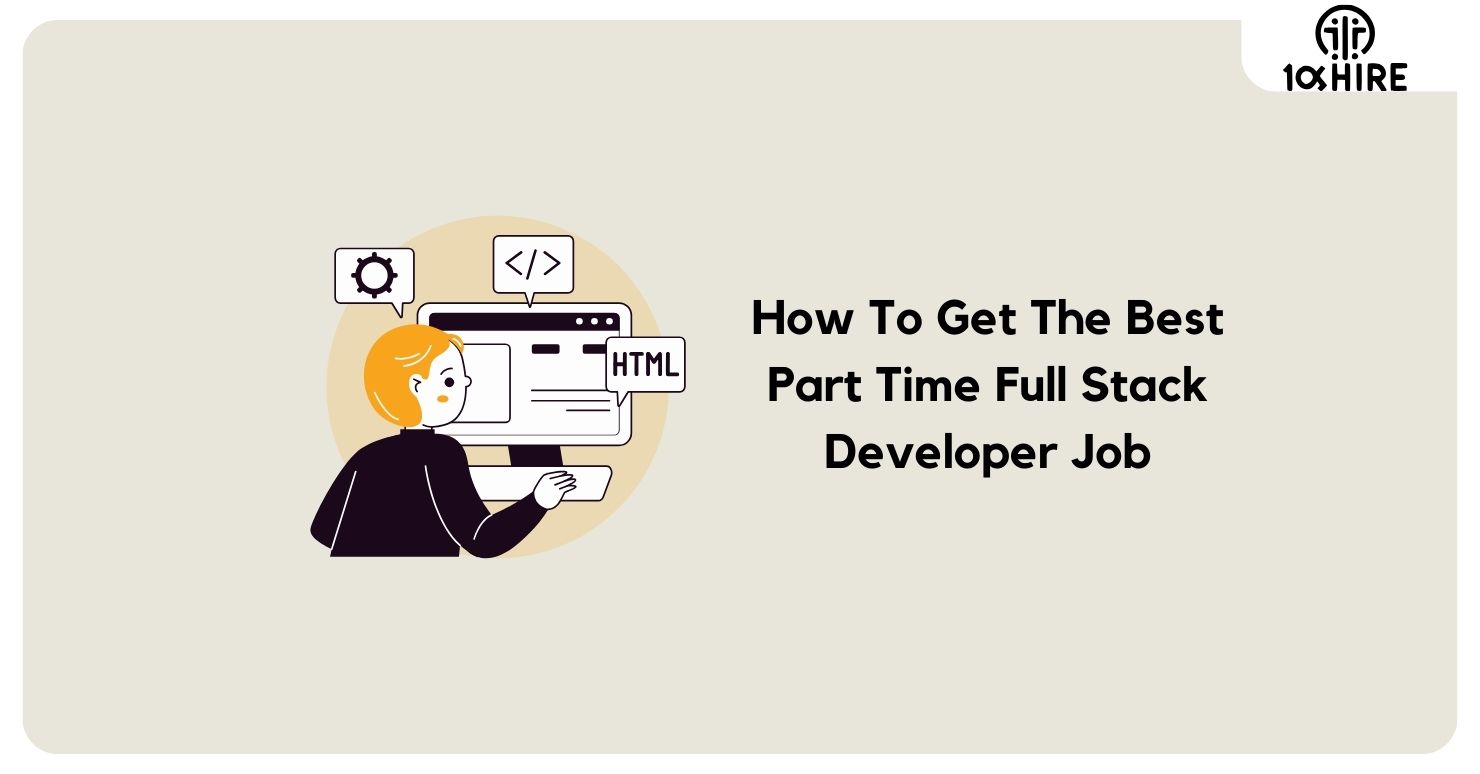Last Updated: November 2025
Embarking on the quest for the ideal part-time full-stack developer job is a thrilling journey filled with possibilities. In a digital landscape that’s constantly evolving, the demand for versatile tech professionals is soaring.
A recent survey shows that this year witnessed a notable rise in employment flexibility, in India alone, especially for freelancers and the self-employed, with a commendable increase of 10.47%. Furthermore, part-time opportunities also expanded, reflecting a growth of 3.84%, while part-time self-employment saw a noteworthy increase of 3.01%.
These statistics underscore a promising trend, making it an opportune time for aspiring part-time full-stack developers to explore and capitalize on the evolving job market dynamics.
Buckle up as we unveil a comprehensive guide to effortlessly secure the best part-time full-stack developer position. From mastering sought-after skills to navigating the job market strategically, this guide is your roadmap to a rewarding and flexible tech career.
Let’s dive into the dynamic world of part-time coding!
Table of Contents
I. Key Skills and Technologies
A. Essential Part Time Full-Stack Developer Skills
A. Tailoring Your Resume for Part Time Full-Stack Developer Roles
B. Showcasing Projects and Achievements
C. Highlighting Relevant Experience and Skills
A. Popular Part-Time Job Platforms
B. Effective Profile Building and Optimization
C. Leveraging Networking Opportunities
IV. Part-Time vs Full-Time Compensation
A. Understanding Part-Time Compensation Trends
B. Negotiation Strategies for Part Time Full-Stack Developer Roles
A. The Rise of Remote Part-Time Opportunities
B. Tips for Effective Remote Work as a Part Time Full-Stack Developer
VI. Staying Updated on Industry Trends
A. Importance of Continuous Learning
B. Resources for Keeping Up with Industry Changes
VII. Building a Strong Online Presence
A. Creating an Impressive Portfolio
B. Active Participation in Developer Communities
C. Showcasing Skills on Social Media Platforms
VIII. Job Interview Strategies
- Preparing for Technical Interviews
- Showcasing Problem-Solving Abilities
- Common Full Stack Developer Interview Questions
IX. Case Studies and Success Stories
A. Real-Life Experiences of Part Time Full-Stack Developers
B. Learning from Successes and Challenges
X. Conclusion
I. Key Skills and Technologies
A. Essential Part Time Full-Stack Developer Skills

1. Front-end Proficiency
To secure a part-time full-stack developer job, having strong front-end skills is crucial. Employers often prioritize candidates who excel in HTML, CSS, and JavaScript, as these are foundational for creating engaging user interfaces.
According to a survey by Stack Overflow,

2. Back-end Expertise
The process of developing an interactive and intuitive website on the server side refers to back-end expertise. They excel in technologies like Python, Java, or Node.js to work on aspects like security, performance, and response of the site.
Going by the same above-given Stack Overflow survey, 42.65% of developers worldwide reported using Node.js for their back-end development, highlighting its significance in the industry.
3. Database Management Skills
For a part-time full-stack developer job, honing your database management skills is vital. Database efficiency allows you to store, retrieve, and manipulate data, which is integral to building dynamic and scalable applications.
In 2023, the worldwide market for database management systems (DBMS) surpassed USD 72.35 billion and is anticipated to exhibit a compound annual growth rate (CAGR) of 10.8% from 2024 to 2032.
This statistical data underscores the growing demand for professionals with expertise in database management.
4. Version Control
Understanding version control is crucial for your part-time full-stack developer journey. Version control systems like Git enable you to track changes to your code, collaborate effectively with team members, and revert to previous versions if needed.
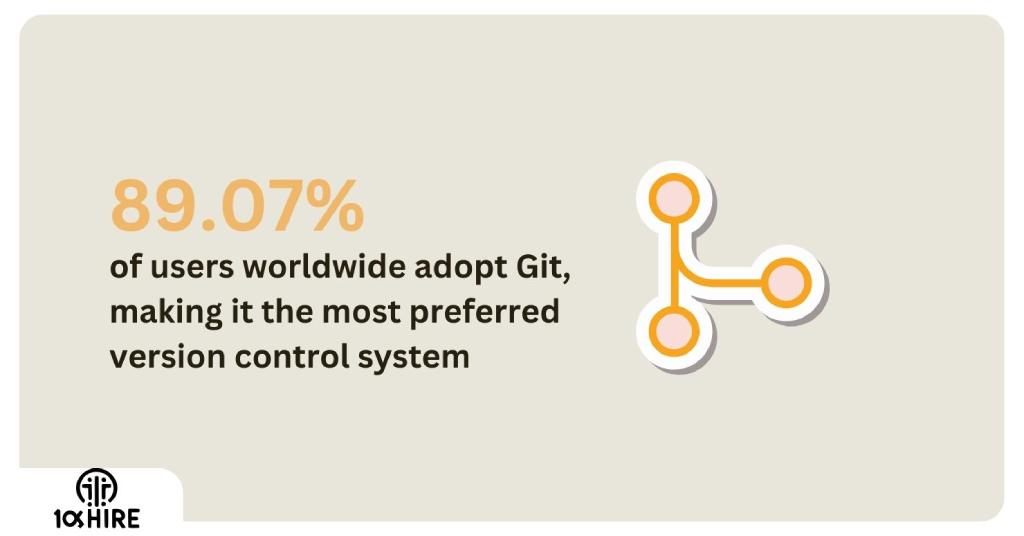
B. Trending Technologies
1. Current Frameworks and Libraries
To successfully land a part-time full-stack developer role, being proficient in the following frameworks and libraries can significantly enhance your prospects:
Frameworks:
- React.js
- Angular
- Vue.js
- Node.js
- Django
- Flask
- GraphQL
- Spring Boot
Libraries:
- Redux – Use it for managing application state in React.js.
- Express.js – Build web applications with Node.js.
- Axios – Make HTTP requests in JavaScript.
- React Router – For client-side routing in React.js.
- jQuery – Simplifies JavaScript interactions.
- Bootstrap – Design responsive web templates.
- Material-UI – This is a React component library with Google’s Material Design.
- TensorFlow.js – Helps in machine learning in JavaScript.
These frameworks and libraries cover a range of technologies commonly used in part-time full-stack development roles, providing a solid foundation for success in the field.
2. Emerging Technologies in Full Stack Development
Right now, web development is a highly attractive field and can be done with basic coding knowledge. Low-code development enables you to create websites by just dragging and dropping elements onto the model logic, making it easier for your clients to understand.
While low-code development is convenient, you need a more strategic approach to achieve better results. You can integrate new technologies like Blockchain, Artificial Intelligence (AI), Internet of Things (IoT), etc., to develop more enhanced and efficient processes.
II. Crafting a Winning Resume
A. Tailoring Your Resume for Part Time Full-Stack Developer Roles
To attract the best part-time full-stack developer in India, ensure your resume is tailored to highlight relevant skills and experiences. Include a clear and concise summary at the top, emphasizing your proficiency in key technologies such as HTML, CSS, JavaScript, and any additional frameworks or languages you specialize in.
Highlight your part-time work experience, freelance projects, or internships related to full-stack development. Focus on showcasing your ability to manage projects efficiently, collaborate with teams, and deliver high-quality results within flexible time frames.
Ensure your resume reflects your passion for continuous learning and staying updated with the latest trends and technologies in the field. Mention any relevant certifications, online courses, or personal projects that demonstrate your commitment to expanding your skills as a part-time full-stack developer.
Tips to make your resume stand out
- Utilize Statistics: Showcase your contributions with statistics. For instance, if you’ve managed a department, quantify its scope and size. Or, showcase how you’ve optimized team output, such as increasing efficiency by 20% through implementing new processes.
- Customize for Each Role: Tailor your resume to address the specific needs of each role. This demonstrates your dedication and makes your application more relevant to the employer.
- Proofread Thoroughly: Proofread your resume meticulously, to avoid errors. Even minor errors in spelling and grammar can leave a negative impression.
- Incorporate Keywords: Use keywords from job descriptions to align your resume with the requirements of the role. This increases the visibility of your resume to applicant tracking systems (ATS) and hiring managers.
- Pay Attention to Formatting: Use clear headings, bullet points, and consistent formatting throughout. A clean layout enhances readability and professionalism.
Avoid These Common Resume Mistakes
- Lying About Your Experience: Be honest about your skills and experiences. Fabricating information can damage your credibility and harm your chances of getting the job.
- Being Overly Descriptive: Keep your descriptions concise and to the point. Avoid unnecessary details that do not add value to your application.
- Including Irrelevant Experience: Only include relevant experiences for the job you’re applying for. Adding irrelevant details can dilute the focus of your resume and distract recruiters from your relevant qualifications, potentially harming your job application.
- Not Including Your GitHub Portfolio or LinkedIn Profile: Showcase your work by including links to your GitHub portfolio or LinkedIn profile, especially if you have relevant projects or endorsements from colleagues.
- Naming Your Resume File Properly: Use a professional and easily identifiable file name for your resume. This makes it easier for recruiters to organize and locate your application among other candidates’ files. Avoid giving the generic name Resume.pdf
Sending the Same Resume: Sending generic resumes to multiple companies at the same time is a big no.
B. Showcasing Projects and Achievements
When highlighting your projects and achievements in your resume, focus on quantifiable outcomes. Highlight specific achievements, like boosting revenue through AI/ML projects or spearheading valuable initiatives. This provides measurable evidence of your impact and demonstrates your value to potential employers.
Ensure your full stack resume follows a structured format. Include a header with a title, professional summary, experience, skills, achievements, and certifications. This organization makes it easier for recruiters to quickly assess your qualifications and accomplishments, enhancing your chances of securing an interview.
Consider the length of your resume. Ideally, a full-stack developer resume should be one to two pages long, depending on your experience and achievements.
Avoid making it too lengthy, as recruiters may lose interest. Ensure it is brief and centered on the most pertinent details.
Illustrate your achievements by highlighting the challenges you faced and how you overcame them. Especially emphasize instances where you achieved quantifiable results. This not only showcases your problem-solving skills but also demonstrates your potential value to prospective employers.
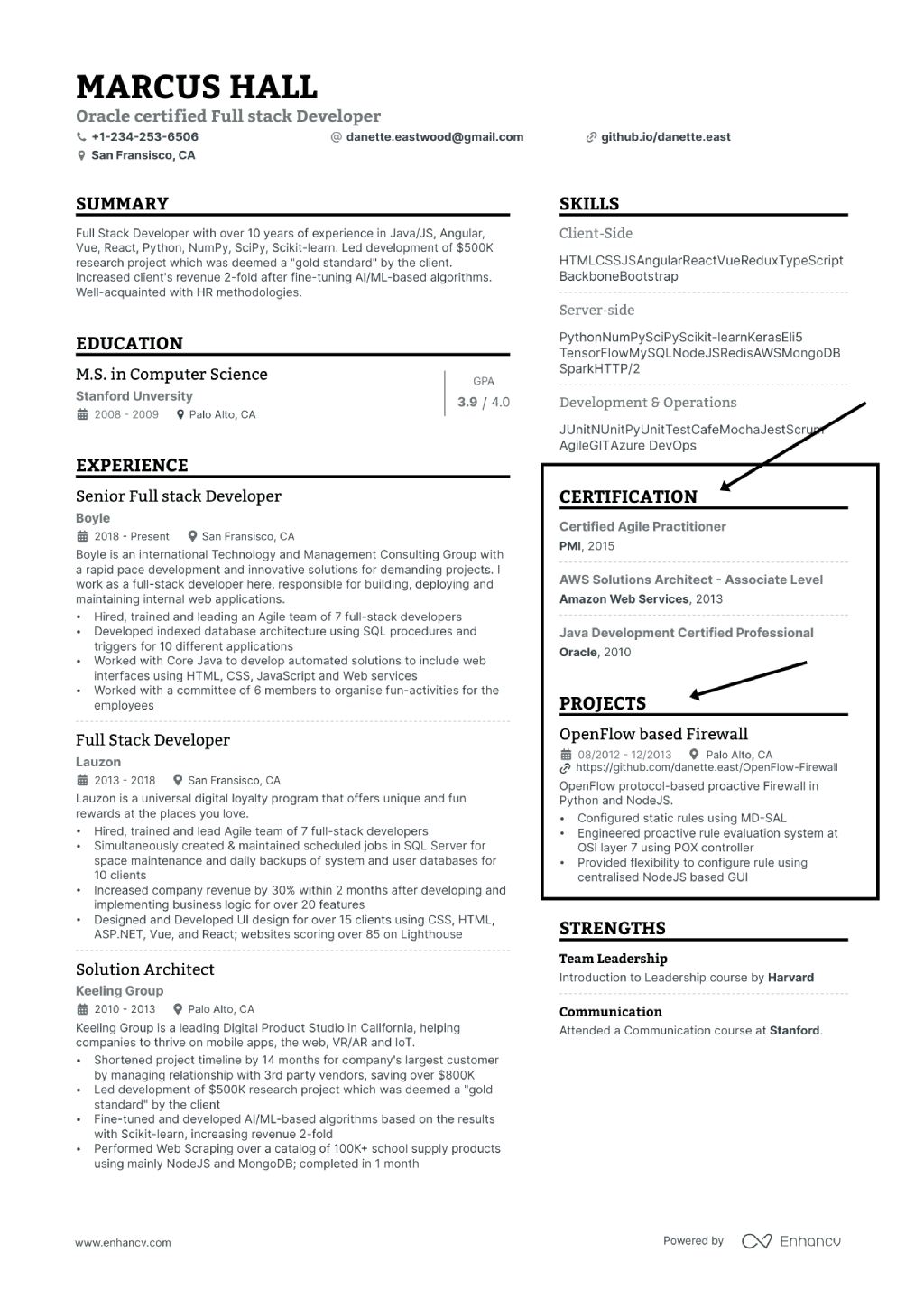
Let us now dig a little deeper into creating an impact through the rightful addition of your achievements.
How to Quantify the Achievements on Your Resume
- List of Proficiencies: Enumerate your skills by listing the number of languages and frameworks you’re proficient in. This provides a clear indication of your technical capabilities to potential employers.
- Projects Completed: Highlight the number of projects completed in each primary technology. This demonstrates your hands-on experience and expertise in various technologies.
- Percentage Improvement: Specify the percentage improvement in website performance or load times after your optimizations. This will portray your ability to deliver tangible results.
- Team Collaboration: Mention the number of team members you’ve led or collaborated with on major projects to indicate your leadership skills and ability to work effectively within a team environment.
- Bug Reduction: Note any reduction in bugs or issues post-launch after your contributions, thereby demonstrating your attention to detail and the value you bring to project success.
C. Highlighting Relevant Experience and Skills
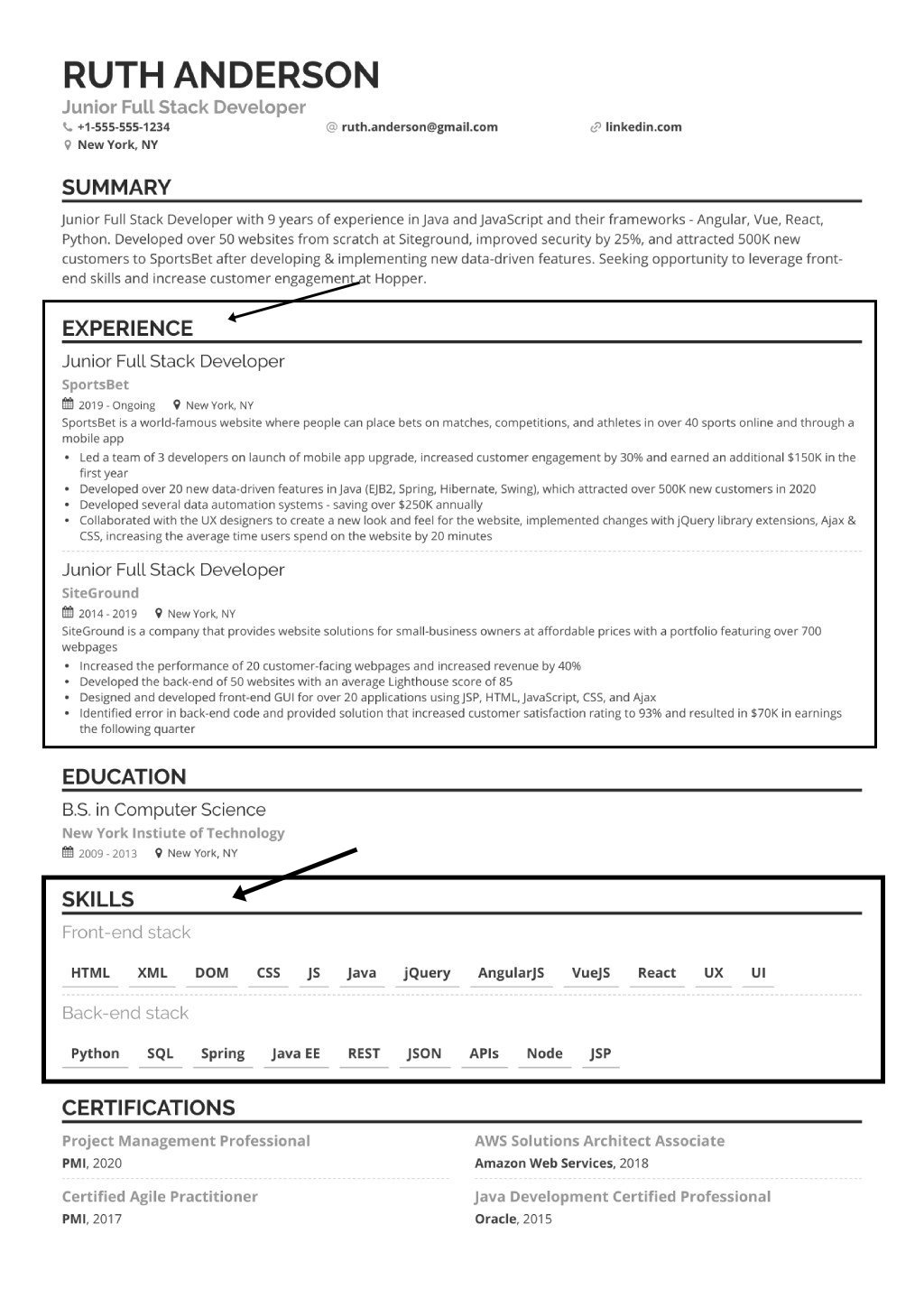
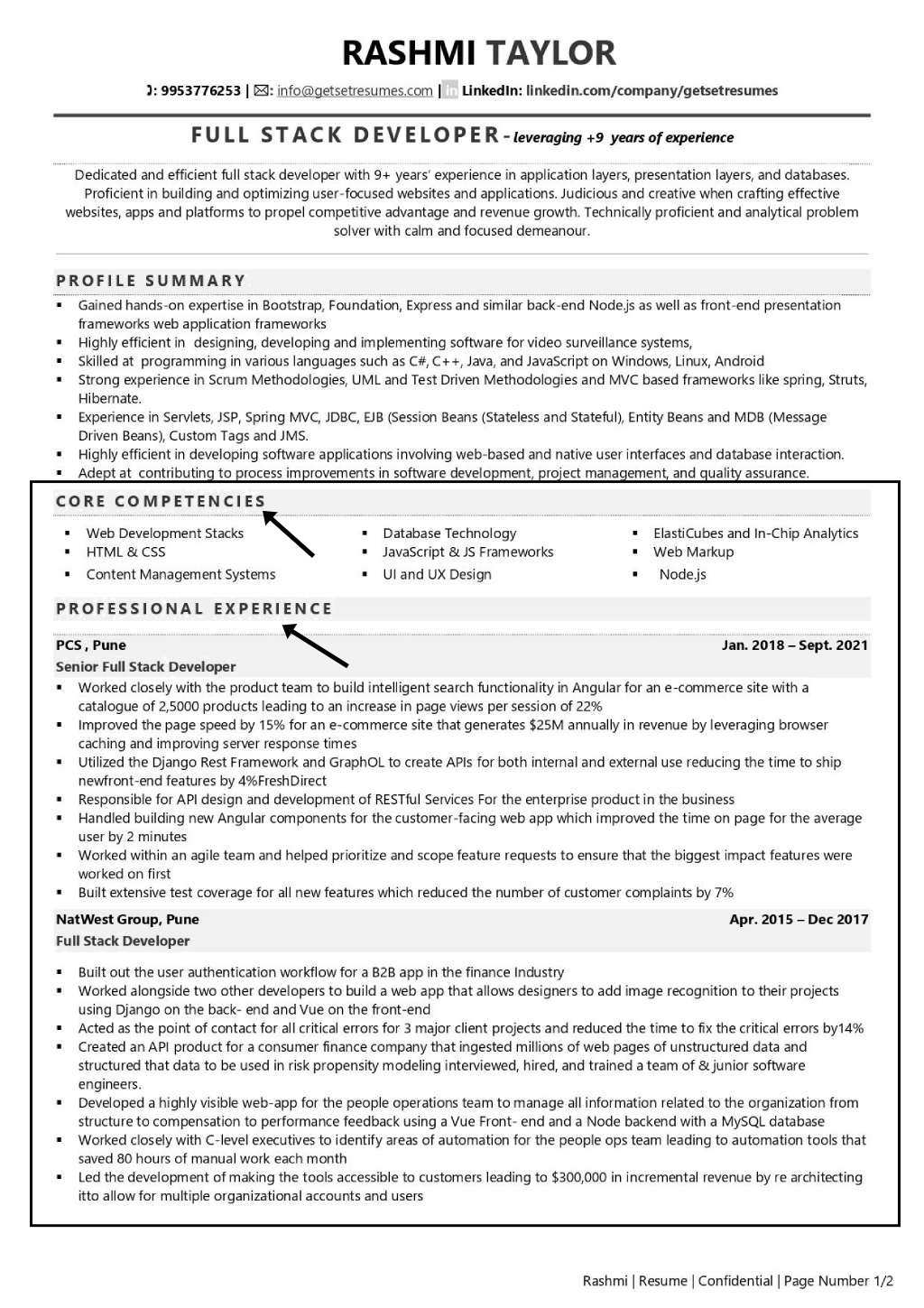
Recommended read: How To Get The Best Full Stack Developer Job As A Fresher
III. Navigating Job Platforms
A. Popular Part-Time Job Platforms
- Naukri.com: One of the largest and most popular job portals in India, offering a wide range of part-time job opportunities for full-stack developers.
- Indeed: Another widely used job platform where you can find numerous part-time full-stack developer job listings in India.
- LinkedIn: A professional networking platform that also serves as a job portal, featuring a variety of part-time job opportunities for full-stack developers, often posted by reputable companies.
- Monster India: Known for its extensive database of job listings, Monster India is a reliable platform for finding part-time full-stack developer roles across various industries.
- TimesJobs: Offering a user-friendly interface and a plethora of job listings, TimesJobs is a go-to platform for part-time job seekers in India, including full-stack developers.
B. Effective Profile Building and Optimization
To enhance your profile as a part time full-stack developer on job platforms, emphasize your skills and experiences while incorporating job-specific keywords. This helps recruiters find candidates with profiles similar to yours.
Inserting relevant keywords in your resume can significantly increase your chances of getting shortlisted for part-time full-stack developer roles. For example, if a job requires skills like requirement gathering, full-stack development, coding, testing & debugging, and application migration, including these keywords in your resume enhances the likelihood of being shortlisted.
Ensure your resume includes key skills that align with the job requirements, such as requirement elicitation, code development, and application migration. By highlighting these essential skills, you increase your visibility to recruiters and improve your chances of being selected for part-time full-stack developer positions.
| SOFT SKILLS | HARD SKILLS |
| Communication | Agile/Scrum/Waterfall Methodologies |
| Innovation | Delivery Management |
| Decision Making | Process Automation & Optimisation |
| Problem-Solving | Full Stack Development |
| Team Building | Project Management |
| Collaboration | Embedded System Support |
Source: naukri
C. Leveraging Networking Opportunities
1. Ethical Networking
Networking ethically as a part-time full-stack developer is crucial for advancing your career. Be transparent and honest in your interactions, respecting others’ boundaries and privacy.
Additionally, take accountability for your actions and mistakes, and always strive to learn and grow from your professional connections. By networking with integrity, you can discover new opportunities and expand your professional circle in the field of part-time full-stack development.
2. How to Ask for Help
Learning how to ask for help is essential for part-time full-stack developers seeking career growth. When reaching out to your network, be honest and express gratitude for any assistance provided.
Whether you’re seeking recommendations for mentors, resources, or job guidance, don’t hesitate to seek support from more experienced professionals to navigate your career path effectively.
3. Importance of Networking in the Tech Industry
By building connections, you can expand your professional network, increase your chances of finding job opportunities, and receive valuable referrals from peers and industry professionals.
Moreover, networking allows you to stay updated on new technologies and industry trends. Attending events and meeting new people helps you stay ahead of the curve and remain competitive in the ever-evolving tech landscape.
Additionally, networking can lead to finding mentors who can offer guidance and advice. In a competitive industry like tech, having a mentor can provide invaluable insights and support to help you advance your career by grabbing the best part-time full-stack developer job in India.
IV. Part-Time vs Full-Time Compensation
A. Understanding Part-Time Compensation Trends
As a part-time full-stack developer in India, it’s crucial to understand the compensation trends specific to part-time roles. Part-time compensation typically varies based on factors such as experience, skills, project complexity, and market demand. Understanding these trends can help you negotiate fair compensation packages and make informed decisions about part-time opportunities.
In India, you can earn somewhere between ₹600 to ₹3000 per hour as a part-time full-stack developer, depending on your skill level and project complexity. For handling complex projects, your rates can exceed ₹5000 per hour.
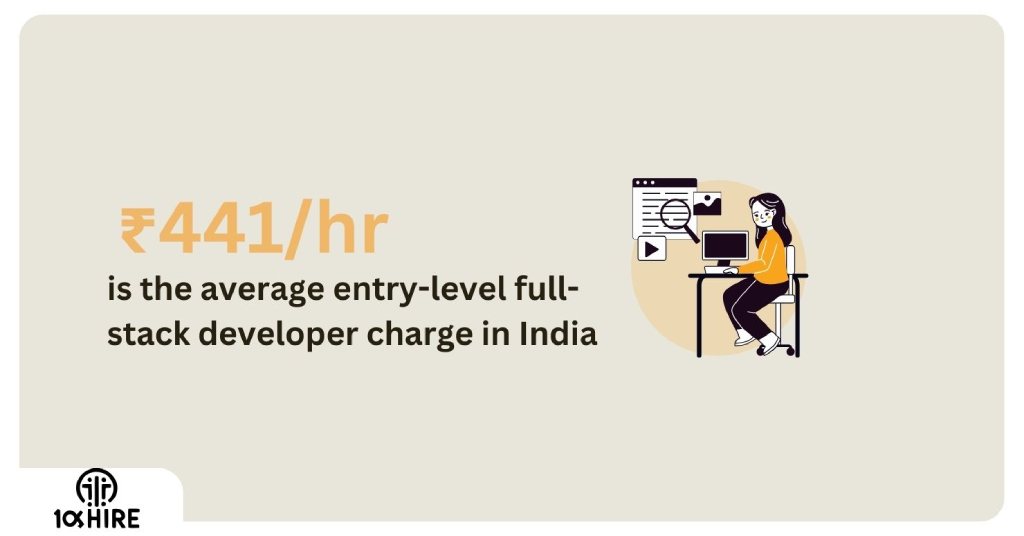
₹5,00,000/year is the average part-time income for a full-stack developer in India, which is only 34% less than the full-time developer income of ₹6,70,000 per annum.
Skill-based Hourly Compensation
| Skill | Charges (per hour) |
| JavaScript | ₹364.38 |
| React.js | ₹379.51 |
| Node.js | ₹354.03 |
| Java | ₹336 |
| SQL | ₹306.02 |
| Angular.js | ₹173.08 |
B. Negotiation Strategies for Part Time Full-Stack Developer Roles
As a part of the hunt for the best part-time full-stack developer job, negotiation plays a crucial role in securing fair compensation for your skills and expertise. Start by researching the market rates for part-time developers in your area and industry, considering factors like experience and project complexity. Additionally, emphasize the value you bring to the table, highlighting your unique skills and contributions to potential employers.
Hourly Compensation for Roles
| Role | Charges (per hour) |
| Software Developer | ₹370 |
| Software Engineer | ₹600 |
| PHP Developer | ₹500 |
| Java Developer | ₹375 |
| Web Developer | ₹393 |
Source: payscale
Also, as per a Glassdoor survey,
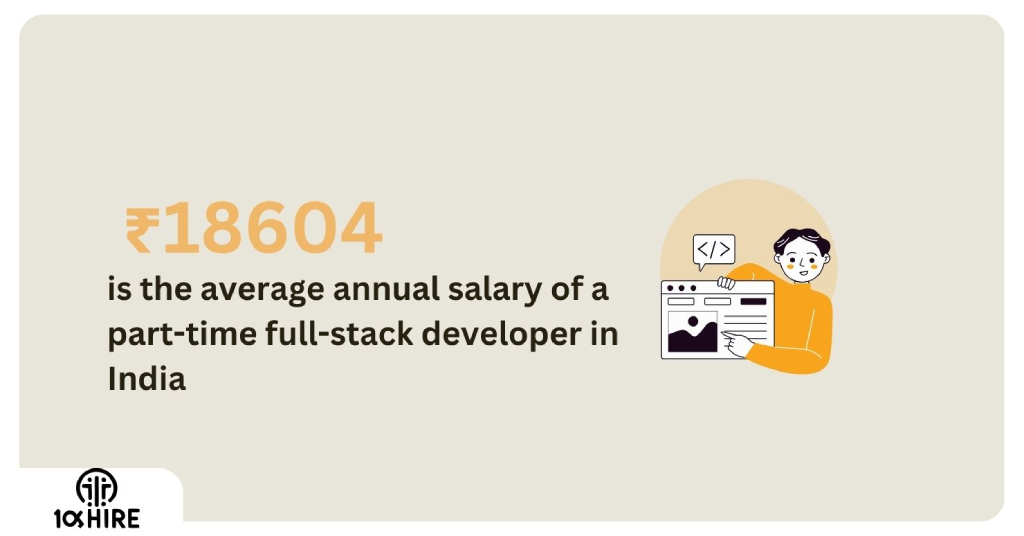
Industry-based Hourly Compensation
| Industry | Charges (per hour) |
| IT industry | ₹394.23 |
| Financial services | ₹428.85 |
| Software | ₹504.81 |
| Hardware & Networking | ₹389.42 |
| BPO sector | ₹350.96 |
| Internet industry | ₹673.08 |
Source: upgrad
Salary by Location

Recommended read: How To Get The Highest Paying Full Stack Developer Job?
V. Remote Work Considerations
A. The Rise of Remote Part-Time Opportunities
It’s important to recognize the increasing availability of remote work opportunities on a day-to-day basis. With advancements in technology and communication tools, many companies now offer part-time positions that can be done remotely.
Embrace this trend by leveraging your skills and flexibility to explore remote part-time opportunities that align with your career goals and lifestyle preferences.
- LinkedIn: Lists 800+ remote job openings for full-stack developers, as of date.
- Naukri: More than 1200 remote positions are available for developers, in India alone.
- Indeed: One of the leading portals, Indeed also offers around 300+ remote openings currently.
- Glassdoor: Find over 600 remote vacancies plus hourly/project-based offers with various leading companies.
- Turing: Enroll on Turing to find remote full-stack developer jobs not only in India but also US and other locations. Additionally, you can enjoy working from your comfort space.
B. Tips for Effective Remote Work as a Part Time Full-Stack Developer
- Ensure Reliable Connectivity: Have a stable internet connection to facilitate smooth communication and collaboration. Use reliable video conferencing tools for virtual meetings with remote teams.
- Create a Dedicated Workspace: Establish a designated workspace that is conducive to productivity and focus. Set up your workspace with the necessary equipment and tools for efficient work.
- Define Clear Work Hours: Specify a consistent work schedule to maintain a sense of routine. Clearly communicate your availability to team members to coordinate effectively.
- Maintain Regular Communication: Stay in touch with your team through regular updates and progress reports. Employ communication channels like chat platforms or emails for quick exchanges of information.
- Utilize Project Management Tools: Make use of project management tools to track tasks, deadlines, and project progress. Collaborate with team members effectively by sharing documents and updates on these platforms.
- Practice Self-Discipline: Stay disciplined with time management to meet project deadlines and commitments. Minimize distractions during work hours to maintain focus on tasks at hand.
- Foster a Healthy Work-Life Balance: Establish clear distinctions between your professional and personal life to prevent burnout. Ensure to take regular breaks and participate in activities that foster relaxation and overall well-being.
- Stay Updated with Team Activities: Participate in team meetings, discussions, and virtual events to stay connected and informed about project developments and changes within the remote team environment.
VI. Staying Updated on Industry Trends
A. Importance of Continuous Learning
Continuous learning holds numerous benefits for part-time full-stack developers in India. Firstly, it ensures you remain updated on the latest technologies and industry trends, allowing you to adapt swiftly to changes in the tech landscape.
Secondly, continuous learning enhances your skills and knowledge, making you a valuable asset to your team or company. This improvement can lead to career advancement opportunities and increased professional value.
Lastly, continuous learning keeps you motivated and engaged in your work by preventing it from becoming monotonous. Embracing new knowledge and skills helps maintain enthusiasm and a sense of fulfillment in your role as a part-time full-stack developer.
B. Resources for Keeping Up with Industry Changes
You’ll find ample resources to fuel your continuous learning process:
- FreeCodeCamp – An open-source interactive learning web platform that comprises an online community, forum, chat rooms, online publications, and local organizations.
- Books – Here are some recommended fullstack development books that are well-structured and offer clear explanations. They include theory, exercises, examples, and practice problems for practical, hands-on learning experiences.
- NET Core 3 and Angular 9: Learn how to use NET Core 3.1, Entity Framework Core, and Angular 9 to build a modern web application.
- The Full Stack Developer: Gain a deep understanding of the technical fundamentals and the non-programming skills necessary for success as a full-stack web developer.
- Fullstack Vue: Master the complete framework of Vue.js with solid foundations, in less time, even if you are a beginner.
- Online Courses – Choose from the plethora of education platforms available:
- Coursera – Best full-stack web development courses online.
- edX – Online full-stack development courses and programs
- Udemy – Master Laravel, Vue 3, & Inertia full stack in this 2024.
- Udacity – Free full stack foundations course with fundamentals of back-end development.
- Simplilearn – Simplilearn’s Full Stack Developer Master’s program trains you to excel in both back and front-end developments.
VII. Building a Strong Online Presence
A. Creating an Impressive Portfolio
- Highlight Your Best Work: Showcase your top projects that demonstrate a range of skills and technologies. Include detailed descriptions, screenshots, and links to live projects, if possible.
- Keep it Clean and Professional: Design your portfolio website with a clean, professional layout that is easy to navigate. Use consistent branding, color schemes, and fonts to maintain a cohesive look.
- Showcase Your Process: Provide insights into your development process, such as wireframes, mockups, and code snippets. Explain the challenges faced and how you overcame them to add depth to your portfolio.
- Include Testimonials and Recommendations: Add testimonials from clients or colleagues who can vouch for your skills and work ethic. Display recommendations or endorsements from previous employers or mentors.
- Demonstrate Versatility: Showcase a variety of projects that highlight different aspects of your skills, such as front-end design, back-end development, and database management. Show your ability to work on different platforms and frameworks to appeal to a broader range of potential clients.
- Optimize for Mobile and SEO: Ensure your portfolio website is mobile-responsive, as many users browse on smartphones and tablets. Optimize your website for search engines by using relevant keywords and meta tags in your content.
By following these tips, you can create an impressive portfolio that effectively highlights your skills, experience, and professionalism as a part-time full-stack developer in India.
B. Active Participation in Developer Communities
While there are multiple community platforms available, research for active ones like:
- Stack Overflow: A well-known platform for developers to ask questions, share knowledge, and collaborate on coding problems.
- GitHub Community: GitHub hosts a vibrant community of developers collaborating on open-source projects, sharing code, and offering support.
- Dev.to: Here, developers share articles, discussions, and insights on various programming topics.
- Reddit Programming Communities: Subreddits like r/programming, r/webdev, and r/javascript offer communities for developers to discuss trends, ask questions, and share resources.
- Hashnode: A platform for developers to blog, connect with other developers, and participate in discussions on various tech topics.
- Micro-communities: These can include Slack channels, Discord servers, or specialized forums focused on specific technologies or interests, such as Reactiflux for React developers, Laravel Chat for Laravel developers, or Kotlinlang Slack for Kotlin enthusiasts.
C. Showcasing Skills on Social Media Platforms
Leveraging social media platforms can significantly boost your online presence and showcase your skills to a broader audience.
I. LinkedIn
LinkedIn stands out as the prime social media platform for professional networking, making it an ideal starting point to showcase your skills. Begin by enhancing your profile: click “add profile section,” choose “recommended,” and then select “add featured.”
This feature allows you to include media and links, directing visitors to more details about your previous work. This creates a portfolio right within your LinkedIn profile, enabling you to present your skills and accomplishments effectively.
II. Social Proof
Including social proof, such as reviews or testimonials, in your portfolio is crucial for creating a strong online presence. These endorsements demonstrate that others recognize and appreciate your work, enhancing your credibility.
When adding social proof, ensure to include basic contact details like the person’s name and company. This transparency adds authenticity and further boosts the credibility of your portfolio.
VIII. Job Interview Strategies
A. Preparing for Technical Interviews
Preparing for technical interviews is crucial to land the desired role. Below are the steps to prepare yourself.
- Understand the Job Requirements: Review the job description thoroughly to identify the key technical skills and requirements. Tailor your preparation to focus on the technologies, frameworks, and languages mentioned in the job posting.
- Refresh Your Technical Knowledge: Review basic concepts like data structures, algorithms, and design patterns. Practice coding exercises on platforms like LeetCode, HackerRank, or CodeSignal to improve problem-solving skills.
- Review Past Projects: Be prepared to discuss in-depth your previous projects, including the technologies used, challenges faced, and solutions implemented. Demonstrate your ability to explain code logic, optimizations made, and lessons learned from each project.
- Practice Coding Challenges: Engage in mock interviews or coding challenges to simulate the interview environment. Focus on solving problems using the programming languages and frameworks relevant to the position.
- Learn from Online Resources: Utilize online tutorials, courses, and documentation to deepen your understanding of specific technologies. Follow coding blogs, watch tutorial videos, and join developer communities to stay updated on industry trends.
- Prepare Questions to Ask: Develop thoughtful questions about the company, team structure, project scope, and expectations for the role. Show your interest and initiative by seeking clarification on any aspects of the position or company culture.
By following these steps, you can effectively prepare for technical interviews and demonstrate your proficiency and readiness for the part-time full-stack developer role in India.
B. Showcasing Problem-Solving Abilities
- Responsive Design: Use CSS media queries, flexbox, or grid layouts to create a responsive website that adjusts to different screen sizes and devices.
- Compatibility Testing: Test your website across various browsers, devices, and resolutions to ensure compatibility and usability.
- Adding Interactivity: Implement JavaScript events, functions, and DOM manipulation to add interactivity and functionality to your website.
- Enhancing Features: Utilize JavaScript libraries, frameworks, or APIs to enhance your website’s features and performance.
- Debugging Errors: When facing syntax, logic, or runtime errors, use debugging tools such as browser developer tools, code editors, or online validators to identify and fix the issue.
- Debugging Techniques: Employ techniques like breakpoints, step-by-step execution, or error messages to effectively identify and resolve errors in your web code.
C. Common Full Stack Developer Interview Questions
Here are a few most commonly asked questions to help you get ready:
Q1. How can you incorporate CSS code into an HTML document?
Q2. In brief, what do Semantic Elements refer to in HTML?
Q3. Describe tags, attributes, and elements in HTML.
Q4. Define JavaScript. Also, discuss four commonly used libraries in JavaScript.
Q5. Can you explain what a Callback function is, in JavaScript? Additionally, provide a code snippet as an example.
Q6. Elaborate on the MEAN stack and MERN stack. Give their alternatives.
Q7. Do you understand the concept of scope in AngularJS? And, define the different types of scopes.
Q8. Provide a brief explanation of Directives in AngularJS.
Q9. What are the features of Node.js, and why is it considered a single-threaded framework?
Q10. Elaborate on the term NPM. Plus, discuss the significance of using NPM with Node.js.
Refer for more here, concerning your level of full-stack skills and experience. By answering these questions efficiently, you can demonstrate your proficiency and readiness for the part-time full-stack developer role.
Recommended read: 10 Smart Questions To Ask Recruiter Before Interview
IX. Case Studies and Success Stories
A. Real-Life Experiences of Part Time Full Stack Developers
1. Priya Joshi
“Being a full stack developer is not just a job; it’s a way of life. Each day is a new adventure filled with code, collaboration, and the excitement of building end-to-end solutions. While the challenges are real, the satisfaction of creating something meaningful is immeasurable.” – says Priya Joshi.
2. Avinash Shashikant Dalvi
Avinash shares his story of how he became a full-stack developer on his self-developed platform “internetkatta.com”. He started his developer career in 2010 and went on to become a multi-faceted tech expert as a software engineer, global technical speaker, blogger, and sponsor of open-source projects.
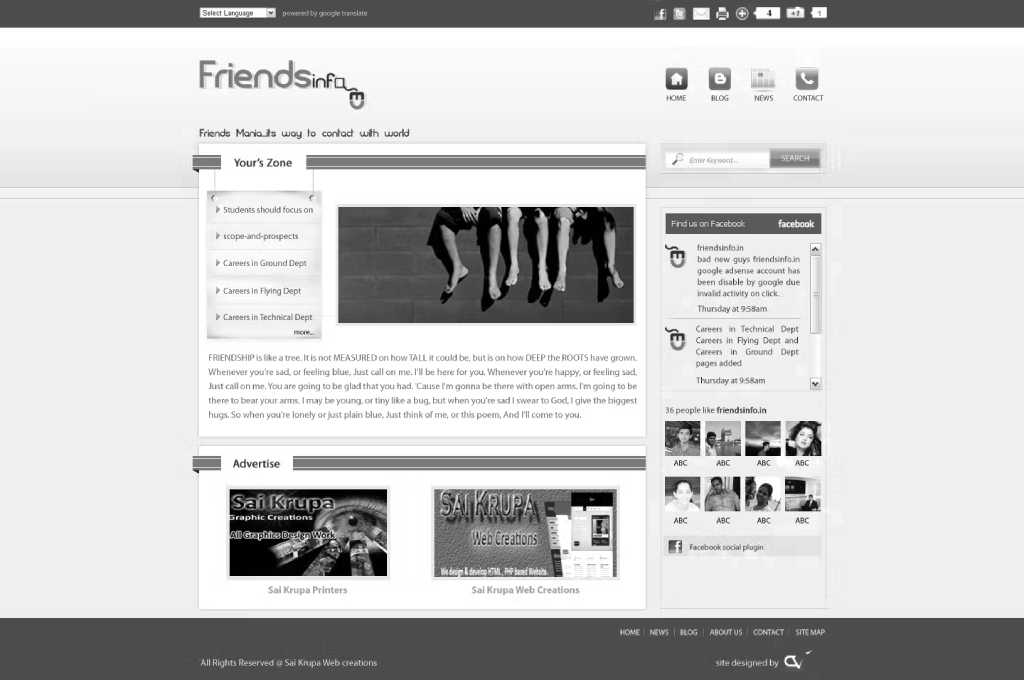
3. Charlie Jeppsson
In a 15000+ worded blog on freecodecamp forum, Charlie revealed how he became a full-stack developer by using the trial and error method. After graduating from a business school, and working as a finance and business analyst for multiple firms, Charlie later discovered his fascination towards coding. He took up online coding courses on portals like Codecademy, Frecodecamp, Code School, and Le Wagon. Finally, he landed up as a successful full-stack developer with various programming skills, frameworks, and language skills.
B. Learning from Successes and Challenges
Caitlyn advises you to become a structured problem-solver to efficiently handle a wide range of challenges including debugging code, designing complex programs, etc. She eventually shares a few tips for the same as:
- Break Problems into Smaller Segments – First, break down a complex problem into smaller and manageable segments to identify the root cause of the problem easily. Concentrate and solve one issue at a time.
- Employ a Methodical Approach – There are two ways to solve a problem. One is the “divide and conquer” method where you make smaller parts and resolve an issue. Two, the “top-down” method of solving from a broader overview till getting into the details.
- Utilize Data for Informed Decision-Making – Do away with the guesswork and rely on data analysis of user behavior, performance metrics, etc.
- Team Collaboration – When you collaborate with fellow developers & designers, problem-solving becomes a breeze with varied ideas and views.
- Consistent Practice – Nothing is impossible when you apply the regular practice. With constant exercise, you can nurture yourself into an agile developer and ace any problems in no time.
X. Conclusion
In conclusion, landing the best part-time full-stack developer job in India requires a blend of technical skills, industry knowledge, and effective job search strategies.
By honing your skills in front-end and back-end development, mastering trending technologies, and showcasing your achievements through a well-crafted resume and online portfolio, you can stand out to potential employers.
Stay updated on industry trends, network actively, and prepare thoroughly for technical interviews to maximize your chances of success in the competitive job market.
Keep striving, and your dream part-time role could be just around the corner!
